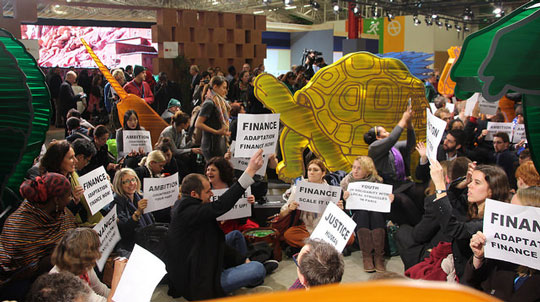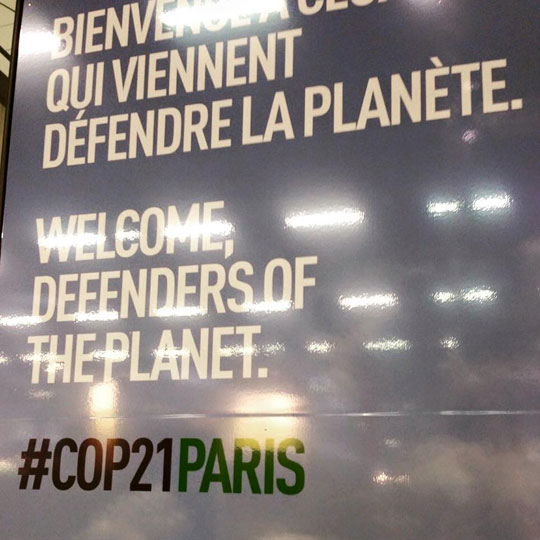In the aftermath of the COP21 climate change conference, the debate over whether the Paris Agreement is a success or a failure is going full blast.
Among other things, the deal sets a high aspirational goal to limit warming below 2C and strive to keep temperatures at 1.5C above pre-industrial levels. This is a far more ambitious target than many expected, though it has been a key demand from vulnerable countries for several years.

Activists hold up signs during a sit in at COP21. Photo: Takver / Flickr
On the plus side, the deal restores some confidence in the UN process, which largely fell apart in Copenhagen six years ago. Copenhagen had left many disillusioned about the prospect of an agreement between countries with highly different priorities and interests. Several commentators have described COP21, which involved 196 countries, as a diplomatic success. For the first time all parties – from industrialised to low-income – have committed to work together to curb greenhouse gas emissions.
But several sticking points have sparked criticisms from diverse voices, including climate scientists and climate justice advocates. They question whether the agreement has any teeth. Particular areas of concern are a lack of credibility in keeping temperature rise below 2C, the non-binding nature of individual pledges to reduce emissions, and the climate finance elements of the deal.
As things stand, countries’ pledges (known as Intended Nationally Determined Contributions (INDCs)), submitted in the run up to COP21, would mean a global temperature rise of between 2.7C and 3C. This badly misses the 1.5 target. And while the overall agreement is legally binding, compliance with the INDCs is not.
However, Prof Nicholas Stern, Chair of the Grantham Research Institute, speaking at a COP21 side event, emphasised the importance of international cooperation in the INDCs and the need to be “legally binding about the process of collaboration”.
The dynamics of the new mechanism requires specific attention too. The INDCs outline climate actions countries intend to take post 2020. But under the so-called “Ratchet Mechanism”, countries need to come back to the table every five years to increase their ambition in reaching those goals. In particular, the deal includes regular reviews to deepen emissions cuts. Countries will aim to ‘peak’ global emissions as soon as possible, and then rapidly scale down in the second half of this century.
The politics of sustainability
The polarisation between bad and good views of the deal is no surprise to anybody familiar with the politics of sustainability in general, and climate change negotiations in particular.
Politics has always played a major role in decisions surrounding sustainable development. The long road to Paris was no exception, as with the 1992 UN Conference on Environment and Development. Contested views on sustainability often underlie major policy controversies. These arguments don’t only happen in international platforms, but also across scales whether regional, national, subnational and local.
In a way, the deal appears as a soft compromise between strong calls for actions by climate scientists and activists on one side, and a world where many economies remain hooked on carbon on the other. With a temperature rise target, it seeks to combine a dose of climate science and expectations from vulnerable countries with what is economically and politically achievable within international processes of negotiations.
For example, the deal was constructed to carry legal force, but without legally binding measures, which the US Congress would have likely rejected. It has also been accepted by Saudi Arabia, despite the country’s strong opposition to any move throughout the negotiation process.
Global agenda setting to send signals
The agreement has gone a long way in setting a global climate change agenda and some directions towards change.
Whatever the criticisms, the force of the agreement appears in messages it sends: whether confirming that ‘deniers’ have ‘lost the climate wars’ or, importantly, signaling the end of the fossil fuel era. Commenting on the agreement, the campaign group 350.org said “it’s time for investors to cut their ties with coal, oil and gas by divesting”, adding that a 2C pledge would require keeping 80% of the world’s remaining fossil fuels underground. Government and business leaders also reportedly believe that the new goal to reach net zero emissions post 2050 should hasten the transition away from fossil fuels and to a clean energy economy.
Beyond the rhetoric, the broad scope of the agreement opens the door for many avenues. Whether it is a success or failure will, however, depends on what follows not only at international but also national and subnational levels.
Conventional approaches to policy analysis would tell us that, since the agenda is set, policy makers just need to move, in a linear fashion, to the next steps of the policy cycle. That is, they explore possible solutions, weigh up alternatives and make “rational” choices about the best policy before implementation can take place.
More politics-aware policy analysts, however, will be very careful in scrutinising solutions pushed forward. They will also look at the political economy of these solutions, including which actors promote them, what their interests are, and the potential winners and losers.
Just as politics played a key role in shaping the Paris Agreement, it will have a big influence on how the Agreement is ‘translated’ in different contexts, all along the different steps of the policy cycle. Shifting the focus to the complex and messy processes by which policy is understood, formulated and implemented, and the range of actors involved, helps understand the politics underlying not-so-neutral or rational policy making.
Considerations will largely be context-specific. But scrutiny will be needed on how problems are defined, how options are considered, whose knowledge and expertise count, and what criteria and appraisal methods are used.
In particular, we should pay close attention to what gets pushed through in the name of the climate, to what purpose, and whether the focus is solely on technological and arithmetic considerations towards carbon emission reductions – or whether broader sustainability goals are embraced, in line with the recent Sustainable Development Goals.

A sign welcoming delegates to COP21. Image: STEPS Centre
A political space up for grabs
The universal deal has opened up a political space, but who grabs it needs careful attention.
In the energy sector, for example, considerations of policy options are likely to provide a battleground for different technologies to reduce carbon emissions. The 1.5C target may well become instrumentalised towards a technological push towards low carbon technologies, based on narrow emission assessments but with varying sustainability impacts.
The plethora of side-events running in parallel to the official COP21 negotiations provided a glimpse of these potential ‘climate solutions’. They included not only renewable energy technologies, both on-grid and off-grid, but also nuclear power and carbon capture storage (CCS). Arguments for geo-engineering, while not obviously loud during COP21, may also come back in full force at some point.
On 12 December, the 1.5C target was symbolically displayed on the Eiffel Tower. This may be a political move, and the NDCs (as they are now called) may be non-binding, but they do provide references to hold governments accountable against current and future policies. In its current form, the Paris Agreement offers an opportunity to deal not only with carbon emissions but also to acknowledge broader linkages between dynamic social, environmental and technological systems.
The ‘Road through Paris’
The ‘Road to Paris’ has become the ‘Road through Paris’. The deal – rather than being comprehensive, perfect or an end in itself – provides the foundational basis for potential changes. Much ‘ratcheting up’ – both quantitative and qualitative – will be needed in the coming years for its credibility to be strengthened.
While many issues remain unaddressed, focusing on processes rather than sole outcomes may help debates to be more productive. The evolutionary nature of the deal provides an opportunity to not only occupy the currently-open political space, but also to broaden its scope over time.
Many directions are possible at this stage. What solutions occupy that space and on what and whose terms, will largely depends on pressures to link goals and actions and where these pressures come from.
This article is part of our coverage of the COP21 climate change conference.
Comments are closed.